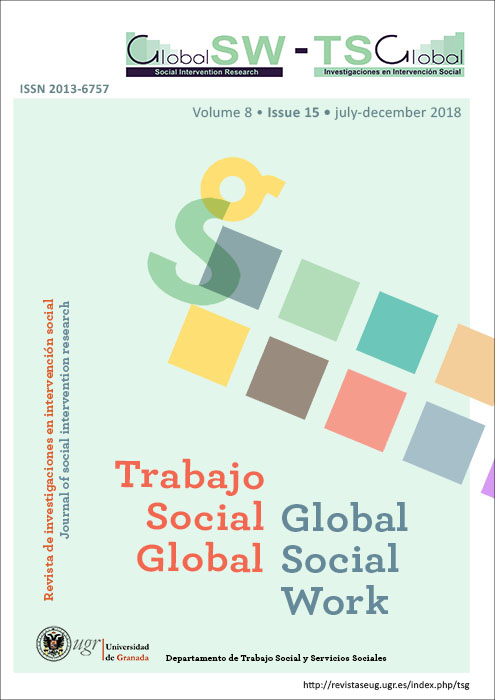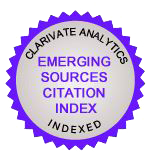Recidivism, risk factors and risk assessment in victims of domestic violence
DOI:
https://doi.org/10.30827/tsg-gsw.v8i15.7424Keywords:
Domestic Violence, Recidivism, Risk Factors, Assessment of Risk FactorsAbstract
For recidivism we understand the number of times that the victim, after one or more episodes of domestic violence, appeals to a specialized support service. Risk factors correspond to indicators that are associated with psychological and psychosocial characteristics of the aggressors, victims and/or relationship between both and, which increase the likelihood of recidivism. The risk assessment allows the collection of indicators on the parties involved in the cycle of violence as well as the implementation of measures that prevent the risk of recurrence and minimise their acute. The study included the administration of an instrument entitled a Risk Monitoring Grid in Cases of Recidivism of Victims of Domestic Violence, consisting of 44 items that allowed the collection of risk factors that promote recurrence and which prevent the victims from ending the cycle of violence. From the data extracted from the Social Service Reports of the Social Service Office of the Functional Unit of Forensic Clinic of the Clinic and Forensic Pathology Service, from Instituto Nacional de Medicina Legal e Ciências Forenses, I. P., it was possible to notice 43 female victims (88.4%), who return between 2012 to 2017. Monitoring and risk assessment in a dynamic and continuous way is essential in the identified cases of violence, since it is assumed as an essential vector in the prevention of violence.
Downloads
References
Almeida, I., e Soeiro, C. (2010). Avaliação de risco de violência conjugal: versão para polícias (SARA: PV). Análise Psicológica 28(1), 179-192. Doi: https://doi.org/10.14417/ap.263
Alves, J. F. (2005). Fatores de risco e indicadores de abuso e negligência de idosos. Universidade do Minho, Minho –Portugal-. Disponível em http://hdl.handle.net/1822/4423
Associação Portuguesa de Apoio à Vitima (2010). Manual Alcipe - Para o Atendimento de Mulheres Vítimas de Violência. 2ª ed. revista e atualizada. Lisboa; Ponta Delgada: Direcção Regional da Igualdade de Oportunidades da Secretaria Regional do Trabalho e Solidariedade Social, do Governo Regional dos Açores. Disponível em www.apav.pt/apav_v2/images/pdf/ManualAlcipe.pdf
________ (2010). Manual Títono - Para o Atendimento de pessoas idosas vítimas de crime e de violência. Lisboa: APAV. Disponível em http://www.apav.pt/intranet16/images/manuais/manuais_intranet/Manual_Titono.pdf
Costa, M. E., e Duarte, C. (2000). Violência Familiar. Porto: Ambar.
Dias, I. (2004). Violência Doméstica: a outra face da família moderna. Violência na Família - uma abordagem sociológica. Porto: Afrontamento.
Douglas, K. S., & Kropp, P. R. (2002). A prevention-based paradigm for violence risk assessment: Clinic and research applications. Criminal Justica and Behavior, 29(5), 617–658. Doi: https://doi.org/10.1177/009385402236735
Douglas, K., & Lavoie, J. (2006). Avaliação e gestão do risco de violência: modelos de utilização e princípios orientadores. Coimbra: Almedina.
Feiteira, L. (2011). Manual de Avaliação de Risco. Instituto Superior de Ciências da Saúde Egas Moniz. Departamento de Investigação e Ação Penal de Lisboa.
Fernandes, C., Moniz, H., e Magalhães, T. (2014). Avaliação e Controlo do Risco na Violência Doméstica. Em Maria Helena Fazenda (Dir). Violência Doméstica – Avaliação e Controlo de Riscos (pp. 223-264). Lisboa: Centro de Estudos Judiciários. Disponível em https://www.fd.unl.pt/docentes_docs/ma/TQB_MA_28328.pdf
Gendreau, P., Little, T., & Goggin, C. (1996). A meta-analysis of the predictors of adult offender recidivism: What works! Criminology, 34(4), 575-608. Doi: https://doi.org/10.1111/j.1745-9125.1996.tb01220.x
Guerra, P. e Gago, L. (Coord.). (2016). Manual Pluridisciplinar - Violência Doméstica: implicações sociológicas, psicológicas e jurídicas do fenómeno. Lisboa: Centro de Estudos Judiciários. Disponível em http://www.cej.mj.pt/cej/recursos/ebooks/outros/Violencia-Domestica-CEJ_p02_rev2c-EBOOK_ver_final.pdf
Lei nº 129/2015, de 3 de setembro. Terceira alteração à Lei n.º 112/2009, de 16 de setembro, que estabelece o regime jurídico aplicável à prevenção da violência doméstica, à proteção e à assistência das suas vítimas. Assembleia da República. Diário da República n.º 172/2015, Série I de 2015-09-03
Maia, L. (2012). Violência Doméstica e Crimes Sexuais - um guia para as vítimas, familiares e amigos. Lisboa: Pactor.
Mascoli, L. (2015). O Homicídio Intrafamiliar: contributos para a avaliação de risco (Tese de Doutoramento). Universidade Fernando Pessoa, Porto –Portugal-. Disponível em https://bdigital.ufp.pt/bitstream/10284/5102/1/Luisa%20Mascoli%20PHD.pdf
Matos, M., Machado, A., Santos, A. e Machado, C. (2012). Intervenção em grupo com vítimas de violência doméstica: Uma revisão da sua eficácia. Análise Psicológica, 30(1-2), 79-91. Disponível em http://www.scielo.mec.pt/pdf/aps/v30n1-2/v30n1-2a08.pdf
Paulino, M., e Rodrigues, M. (2016). Violência Doméstica - Identificar, Avaliar, Intervir. Estoril –Portugal-: Prime Books.
Ribeiro, F. (2017). Violência Doméstica e Co-dependência - (In)Existência de uma Relação. Relatório Final de Estágio. Coimbra –Portugal-: Instituto Superior Miguel Torga.
Santos, M. J. (2010). A perícia médico-legal nos casos de violência nas relações de intimidade. Contributo para a qualidade (Dissertação de Mestrado). Universidade do Porto. Porto –Portugal-. Disponível em
https://repositorio-aberto.up.pt/bitstream/10216/55453/2/teseMjoseMLSantos.pdf
Sistema de Segurança Interna (2017). Relatório Anual de Segurança Interna Ano 2016. Lisboa: Diário da Assembleia da República, II Série E – Número 12. Disponível em
União de Mulheres Alternativa e Resposta (UMAR). (2016). Relatório final dos dados sobre o Femicídio Consumado e Tentado ocorrido em Portugal. Observatório de Mulheres Assassinadas. Disponível em
http://www.umarfeminismos.org/images/stories/oma/2016/Relat%C3%B3rio_Final_OMA_2016.pdf
VV.AA. (2013). Avaliação e Gestão de Risco em Rede. Manual para Profissionais. Associação de Mulheres contra a Violência (AMCV). Disponível em
http://www.pgdlisboa.pt/docpgd/files/1436798180_gestao_risco_emar.pdf
Downloads
Published
How to Cite
Issue
Section
License
Authors publishing in this journal agree to the following terms:
- Authors retain their copyright. They guarantee to this journal the right to a first publication of the work submitted to initiate the editorial process.
- Authors know that their work is published under a Creative Commons License which allows others to share it, with a recognition of the work's authorship and its initial publication in this journal.
- Authors share with Global Social Work explotation rights of the work that has been published in this journal, authorizing the execution of a free reproduction, distribution and public communication. Authors know that their work will be stored on servers and reproduced in digital format for inclusion in institutional repositories and databases that will facilitates free access to the full text of the work.
- Authors may distribute the version of the work published in this journal (for example, to an institutional repository or publish it in a book), with the explicit acknowledgment of its initial publication in this journal.
Copyright on the texts published in Trabajo Social Global -Global Social Work, as well as editorial policy of the journal refering to self-file and deposit in institutional or thematic repositories, are identified in the database





















